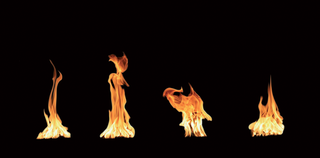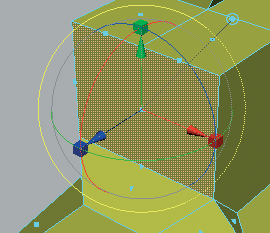
By Peter Kreußel
Hair waving in the breeze, a fluttering cloak, flickering flames - computer-generated images are not what come to mind first when you see realistic scenes like these. But professional 3D rendering and animation programs such as Maya [1], Photorealistic RenderMan [2], and 3ds Max [3] are now more than capable of generating a realistic-looking blaze, simulating malleable materials such as cloth or rubber, or automatically calculating the behavior of fluids. Autodesk Maya 8.5 was released mid-January, with the Complete version at an asking price of US$ 1,999, and the Unlimited version setting buyers back US$ 6,999.
Many of the special effects that distinguish Maya from the free 3D program Blender, such as hair and cloth simulations, are available in the Maya Unlimited version only. The price of the Maya software restricts its use to professionals, which makes it all the more interesting to discover to what extent an open source application can keep up with the major players.
In this article, I provide an overview of the feature set in the new Maya version and also consider how Blender [4] compares as a free alternative.
The basis of any spatial simulation is the wire model that defines the geometry of the body to be represented. Modeling 3D objects is a non-trivial process in itself: because computer screens and mice or digitizers are limited to two dimensions, you can't just model a 3D object on a computer as you would shape a clay model. Instead, graphic artists rely on construction techniques that add a third dimension to two-dimensional drawing actions performed with the mouse.
The basis for organic objects such as the figures and characters in the visual effects of modern movies are typically polygon meshes. They are created by repeatedly subdividing areas into simple basic shapes. In Figure 1, you can still see the cube from which the complex object was created on the left. The ocher-colored object was created by splitting, moving, rotating, and scaling the surfaces of the cube.
Maya has an intuitive approach for this process - it draws a number of rotate and move handles around a selected polygon to reflect the three dimensions (Figure 2). The user can drag one of the colored arrows to move the surface in the direction of the axis in question. Moving the colored cubes at the axis ends scales the selected object up or down; the colored circles rotate about the axis of the same color. The axis colors were standardized in CAD applications many years ago.

After creating a wire model of the basic object, automatic smoothing algorithms then apply an organic shape (Figure 1, right). The designer can apply a realistic-looking surface, typically based on a photo. The 3D software projects (maps) the photo onto the volume object. Virtual light sources add light and shade. The ray-tracing technique used for this follows the path of the ray from the virtual light source, thus simulating light and shade effects, such as the colored shadow that a red object projects onto a white wall. High-performance programs such as Maya, but also the YafRay ray-tracer plugin in Blender, calculate reflections and refractions caused by transparent objects.
In the 3D object-modeling phase, the free Blender program keeps up with the professional application quite well, partly because the latest version 2.43 now has a Sculpt mode as a counterpart to the Sculpt Geometry tool in Maya. Designers can use this tool to interactively deform volume objects by "touching" them with the mouse. This approach comes closest to clay model making and offers maximum freedom and intuitiveness, which really pays off when you need to design complicated organic shapes such as human faces.
Some aspects of real life are particularly difficult to simulate on a computer, including water, fire, and flexible materials - especially clothes that move to reflect the movements of the character wearing them and that throw creases when they touch other solid objects. Additionally, the enormous number of hairs on humans and animals makes it impossible to create manual models.
Blender gained much ground last year, and now also has systems for simulating fluids (version 2.40) and soft bodies (version 2.37). This said, the Autodesk developers have not been twiddling their thumbs: Maya 8.5 now has a simulation system, nCloth, for cloth and other flexible materials. Folding behavior and movement of cloth is now automatically calculated on the basis of preset parameters such as torsional stiffness and density (Figure 3).
For a windy scene, the designer needs to specify the speed and airflow direction. Movements of figures wearing material simulated by nCloth are reflected by realistic-looking fluttering of the cloth. With Maya, you can design inflatable objects [5] in a simple way, or even animate objects that tear or burst.
Blender (currently) has nothing comparable to these features. Note that nCloth is restricted to users with the Unlimited version of Maya.
Whether you are designing creatures from outer space, cuddly toys, or just normal human characters, they have one thing in common: hair. Many computer animation scenes need to render hair in a realistic way to make it look natural. Blender version 2.40 has a feature for this. Hairs are based on a particle system, that is, a system that automatically generates many small parts that move in predetermined ways. The particle system can be set up to draw the particle paths as dotted lines that look like hair. The With Blender, it is much harder to design hairstyles, but not completely impossible.
The hair simulation feature in Maya is in a different league; a number of configurable parameters give designers the ability to make a character's hair curly, smooth, thick, or thin. Maya will even create plaited hair automatically. Hair is organized in groups of follicles. Follicle attributes can be modified individually. In fact, designers can create highlights faster than any hairdresser (Figure 4). If the character moves its head, the virtual hair moves too, without requiring intervention on the part of the the designer.
If the multitude of settings in Maya's hair simulation sounds like too much work, you might be able to achieve sufficiently realistic results more quickly using Maya's fur simulation (Figure 5).
The alternative simulation system for body hair, which has been around longer than Maya Hair, lets you assign one of the fur templates included with the program to a surface. Furs have a realistic-looking structure, but always cover the surfaces they are assigned to smoothly, and cannot be shaped, in contrast to the hair simulation. Both hair and fur simulations are available only in the Maya Unlimited version.
In real life, water is a moving element; waves and currents cause continual shape changes. Simulating these movements manually in a 3D modeler is difficult due to the sheer effort involved. A system that calculates the behavior of fluids on the basis of their viscosity and gravity and the shape and movement of obstacles promises help. Figure 6 shows a scene in which the wave swell interacts with the bow wave of a moving boat. If you get the settings right, both of these movements will be created automatically. The simulation is not restricted to stills; natural fluid movements also can enhance the artistic quality of animated movie sequences.
Although fire and water are natural opposites, animation programs use similar algorithms to represent both. From a physical point of view, both are light-emitting gas streams (Figure 7). The same thing applies to smoke, with the exception of its luminosity. Again, automation in Maya saves manual work; the application provides a number of templates that designers can simply insert into the scene in question.
Ray tracers calculate highlights and shading on surfaces on the basis of the path taken by the rays from a virtual light source. For interior scenes, you can simply add a few lamps to the setting to provide realistic lighting. Of course, it is not so easy to achieve natural-looking lighting for external settings; the idea is to simulate sunlight and diffuse lighting that emanates from the daylight sky. Again, Maya takes this responsibility off the designer's shoulders. A single click on Create Physical Sun and Sky in the rendering settings tells Maya 8.5 to create a realistic outdoor atmosphere.
Blender has a similar option, Skydome, although the results are slightly less realistic. Maya benefits from the power of the Mental Ray ray tracer, especially when simulating external scenes. This software, which was originally developed by Mental Images [6], has established itself as a standard tracer in the movie industry along with RenderMan.
Techniques such as global lighting and final gathering produce extremely realistic results. Global lighting simply means that the simulation takes all physical properties of light into account - an illuminated object becomes a light source itself. Transparent objects break light down into its color components. Final gathering [7] reduces the computational power required for global lighting but also reduces the effect of rounding errors, thus creating smoother images that are easier on the eye.
The limited version of Maya, Maya Complete, costs less than a third (US$ 1,999) of the Unlimited version (US$ 6,999). And the version is "complete" in the sense that it represents a state-of-art solution for 3D modeling, animation, and rendering.
Considering the price, it comes as no surprise that Maya Complete outpaces the free Blender application - usability is where the professional tool scores the most points. Good documentation, which is less comprehensive for the current version of Blender, rounds out the package to make things easier for newcomers. If you are familiar with Blender, just reading the Help file should put you quickly on your way to understanding how the feature-rich program works.
Designers can use Blender to do much of what Maya Complete can do, although the results might not be quite as good. Maya's superior performance comes at a substantial price, and you need to activate the software online before you can use it. The test version remembered the MAC address of the graphics adapter and was restricted to running on this one machine.
Blender has closed the gap to the professional league with simulation systems added since the last version was released (Fluids, Soft Body). But if you need to render human hair, water, and fire of Hollywood quality on your machine, there is simply no alternative to the expensive commercial product.
Besides requiring 3D hardware support and Openmotiv, Maya, which is supplied in the form of separate RPMs for 32- and 64-bit machines, places no other demands on the Linux system. A standard PC is all you need to edit a scene. Rendering individual images with a resolution of 1024x768 took between a couple of minutes and a couple of hours on a test machine with a 3GHz CPU. Complex animations at the standard frame rate of 24 frames per second are definitely the domain of large clusters of computers.
| INFO |
|
[1] Maya: http://usa.autodesk.com/adsk/servlet/index?siteID=123112&id=7635018
[2] Photorealistic RenderMan: https://renderman.pixar.com/ [3] 3ds Max: http://usa.autodesk.com/adsk/servlet/index?id=5659302&siteID=123112 [4] Blender: http://www.blender.org [5] Inflatable objects in Maya: http://download.autodesk.com/us/maya/m85demos/Maya85_FB_Videos/nucleus2/nucleus2.html [6] Mental Images: http://www.mentalimages.com/ [7] Final Gathering: http://www.finalgathering.com/ |